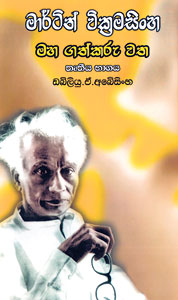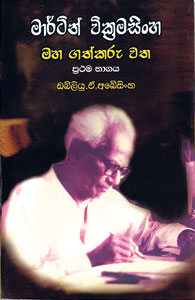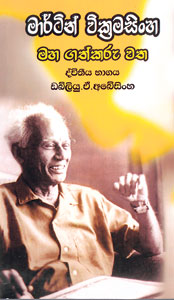It's a unique happening in the history of modern Sinhala literature. The initiative taken by the Martin Wickramasinghe Trust in recording the life of the most outstanding Sri Lankan literary figure of the 20th century has been completed. The monumental work in the form of a trilogy is now available. The first volume came out last September and the other two are also now on the shelves.
'Martin Wickramasinghe Maha Gathkaru Vatha - His Life, Work and Vision' is the title of this three-part publication in Sinhala.
The Trust had entrusted this mammoth task to the well known writer W. A. Abeysinghe respected not only for his writing skills but also for his simplicity and composure. I must confess I have not read the books but glancing through the pages and knowing Abey (that's how I have been addressing him from the days we were together on the Dinamina many decades ago), he has done a thorough job. The Trust picked the right man for the job.
The three volumes cover three distinct periods of the life of the great writer. The first volume covers the period 1890 (he was born on May 29, 1890) to 1947, the year he left the Dinamina where he was Editor. The second covers from 1947 to 1961 and the third from 1961-1976, the year of his death.
Abey admits it was a gigantic task. He was thrilled when he was invited to undertake the job since he had studied Martin Wickramasinghe's works in depth and had associated with him for a fairly long time. Also, he considered it a national duty to record Wickramasinghe's life story. "But I never realised it was going to be so tough. When I began reading his writings as well as the vast amount of articles and books written about him, I felt l was lost in the middle of the sea in a small sailing boat. I thought it was going to be a never ending task," he writes in the preface.
The fact that Abey had had the good fortune of associating with the great author from 1962 until his death would have certainly helped in writing his life story. Abey admits that he is not used to following a well structured plan in whatever he does. "I know it has affected my writing as well. I just get down to the job. I have no faith in being methodical. I do it as it comes. But one thing is, I keep on working. It's not with any ultimate goal or to reach the winning post," he says.
Though Abey confesses to not having a plan when he starts writing, the final result does not indicate that. The reader gets a different impression. He himself mentions that as he went on writing the Wickramasinghe story, the structure evolved. At the end of it he was satisfied with the outcome. Yet he prefers to call the work "an introduction" rather than an attempt at an in-depth study.
"To me his writing is his vision". That is why he has quoted extensively from Wickramasinghe's writings in the three volumes.
His effort is commendable. He gives the reader a rare opportunity to sample a wide range of the great man’s work. The quotes give a vivid picture of the social changes over the many decades as well as Wickramasinghe's creative ability and his thinking.
While presenting the narrative, Abey takes pains to present the event in perspective. In the first volume describing Wickramainghe's youthful days, he talks of the Buddhist renaissance led by Anagarika Dharmapala, who was promoting the anti-British campaign through 'Sinhala Bauddhaya'. The public loved to read the column 'Henaguli' in 'Sandaresa' written by Valisinghe Harischandra. Piyadasa Sirisena wrote to the 'Sinhala Jatiya'.
His novel 'Roslin Jayatissa' (sold at one rupee) came out on the day there was a massive strike by carters in Colombo city. Pettah was deserted. Armed policemen guarded the streets. People were scared and did not get out of their houses. A single cart was not to be seen.
Normally they would transport the goods from the harbour to the wholesale shops and from there to the railway station and retail shops. Wickramasinghe was eager to get a copy of the novel. Against the advice of his friends, he quietly walked through the deserted streets to K. D. Perera & Sons bookstore and bought a copy. Someone asked him for the book for two rupees. He didn't give it. He wanted to read it.
The second volume starts with Wickramasinghe leaving the newspaper world which Abey records, "In 1947 Wickramasinghe bid good-bye to the Dinamina, Lake House and to journalism. He was then 57. Eldest son Sarath Kusum as then 19. Youngest daughter Yuni was seven. He was then residing at 'Premagiri', the house he built in Mount Lavinia.
He left Lake House in disgust. He had been in the newspaper for nearly 27 years as a paid employee in a private firm. He may have felt a free man when he left all the shackles and stepped out. Yet he does not mention any such feelings in his writings."
Abey considers the ten years from 1947-57 as the most lively and dynamic period of Wickramasinghe's life. It was a momentous period in Sri Lanka's social development.
The country had won independence in 1948. In 1956 power was transferred to a new socio-political force. Sinhala became the official language. There was a socio-political and cultural revival. This period saw Wickramasinghe blossoming not only as a novelist and short story writer, but also as a dramatist, poet and literary and social analyst in a class of his own. Abey lists 23 publications released during this period including four English titles.
In the three volumes, Abey analyses Wickramasinghe's writings in detail, most of it in chronological order.
Photographs relating to Wickramasinghe's life have been included in all three volumes along with extensive lists of articles published in newspapers and journals from 1916 onwards, in addition to his large number of books. Milestones provide a quick look at the eventful happenings in his life. All this has been made possible by the fine archive maintained by the Trust thanks to the keen interest taken by Ranga, the youngest son who devotes all his time to bring everything up to date.
The three volumes collectively add up to 1425 pages. While it's fine reading material to the average reader, there is ample material for the research student. Writer Abeysinghe has done a wonderful job - his summing up of the remarkable man in the last few pages deserves special mention.
The Trust no doubt has extended their fullest support to make it a publication worthy of the celebrated writer. An English version, at least in an abridged form would be appreciated by those who are admirers of this eminent Sri Lankan. |




